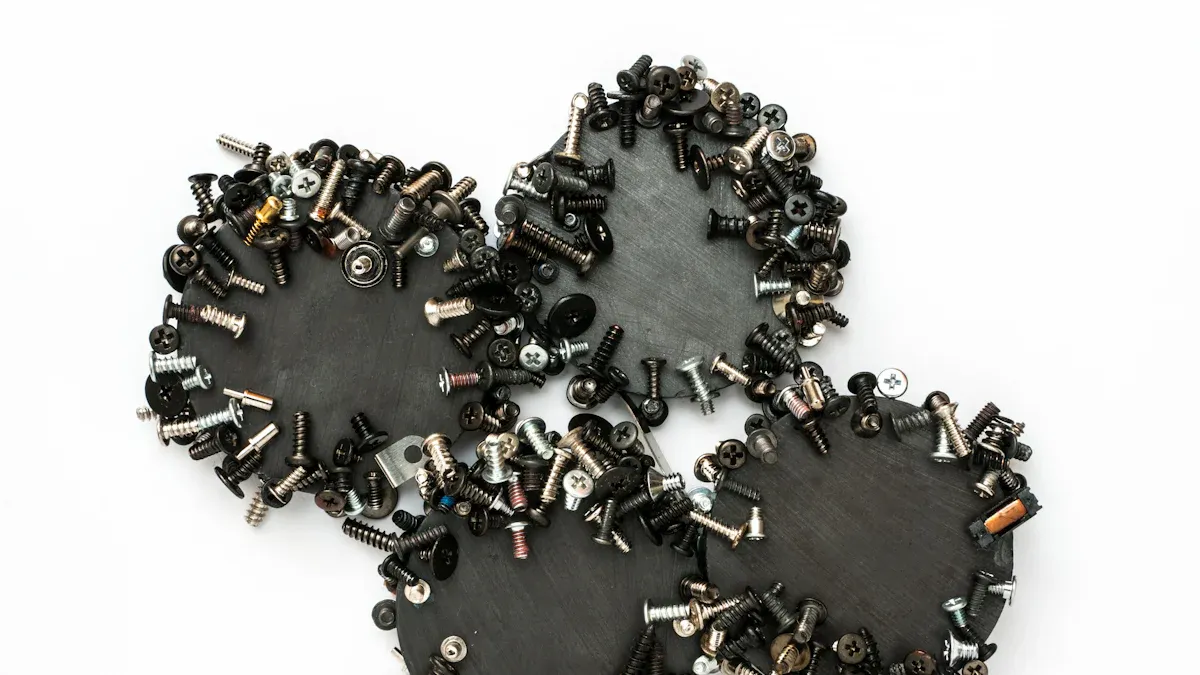
Proper installation of a round pot magnet plays a crucial role in industrial applications. It ensures the magnet delivers maximum holding strength and maintains its durability over time. When installed incorrectly, the magnet may lose efficiency, suffer physical damage, or fail to perform its intended function. This is especially important for tools like a fishing magnet, which require precise alignment and secure mounting to function effectively. By following a systematic approach, users can avoid costly errors and maximize the magnet’s potential.
Key Takeaways
- Wipe the surface clean before starting. Dirt or oil can make the magnet weaker.
- Check the magnet and surface for any damage. Broken parts can cause it to work poorly.
- Pick the best way to attach it for the surface. Use screws for metal or glue for non-metal surfaces.
- Make sure the magnet touches the surface completely. Small gaps can make it hold less strongly.
- Look at the magnet often for damage. Finding problems early keeps it working well.
Pre-Installation Preparation for Round Pot Magnets
Cleaning and Preparing the Surface
A clean surface is essential for the proper installation of a round pot magnet. Dirt, grease, or debris can weaken the magnet’s grip and reduce its effectiveness. To prepare the surface, use a clean cloth or sponge to wipe away any visible contaminants. For stubborn grime, apply a mild cleaning solution and scrub gently. After cleaning, dry the surface thoroughly to prevent moisture from interfering with the magnet’s performance.
Tip: Avoid using abrasive cleaners or tools that could scratch the surface. Scratches can create uneven contact points, reducing the magnet’s holding strength.
Inspecting the Magnet and Surface for Defects
Before installation, inspect both the round pot magnet and the mounting surface for any defects. Look for cracks, chips, or other signs of damage on the magnet. A damaged magnet may not function as intended and could fail under stress. Similarly, check the surface for irregularities such as dents or uneven areas. These imperfections can prevent the magnet from making full contact, which is crucial for optimal performance.
If any defects are found, address them before proceeding. Replace damaged magnets and repair uneven surfaces to ensure a secure and reliable installation.
Selecting the Right Mounting Method
Choosing the correct mounting method is critical for the successful installation of a round pot magnet. The method depends on the application and the type of surface. Common mounting options include screws, bolts, and adhesives. For metal surfaces, screws or bolts provide a strong and durable hold. Adhesives work well for non-metallic surfaces or when a seamless appearance is desired.
Note: Always use fasteners or adhesives that are compatible with the magnet’s material and the surface. Incompatible materials can weaken the bond and compromise the magnet’s performance.
To determine the best method, consider the weight and size of the magnet, as well as the environmental conditions it will face. For heavy-duty applications, opt for mechanical fasteners to ensure stability and safety.
Proper Installation Techniques for Round Pot Magnets

Ensuring Full Contact with the Surface
For a round pot magnet to perform at its best, it must make full contact with the surface. Even a small gap between the magnet and the surface can significantly reduce its holding strength. This happens because air gaps or uneven surfaces disrupt the magnetic field, weakening the bond. Ensuring that the magnet and the surface are flush is critical for achieving maximum magnetic strength.
To verify full contact, inspect the surface and the magnet carefully. The working surface of the magnet should be smooth and free of debris. Similarly, the mounting surface must be flat and clean. If necessary, use a leveling tool to confirm that the surface is even.
Tip: For industrial applications, test the magnet’s performance by placing it on a flat test plate. This ensures that the magnet maintains complete contact and delivers optimal strength.
Using the Correct Fasteners or Adhesives
The choice of fasteners or adhesives plays a vital role in securing a round pot magnet. Mechanical fasteners, such as screws or bolts, are ideal for heavy-duty applications. They provide a strong and reliable hold, especially on metal surfaces. Adhesives, on the other hand, work well for non-metallic surfaces or when a seamless appearance is required.
When selecting fasteners, ensure they are compatible with the magnet’s material. Stainless steel screws, for example, are a good choice for corrosion resistance. For adhesives, opt for industrial-grade options that can withstand environmental factors like heat or moisture.
Note: Always follow the manufacturer’s guidelines for fastener or adhesive use. Improper installation can compromise the magnet’s performance and durability.
Aligning the Magnet for Optimal Orientation
Proper alignment is essential for the round pot magnet to function effectively. The magnet’s orientation determines how well it interacts with the surface and the load it supports. Misalignment can lead to uneven stress distribution, reducing the magnet’s efficiency and lifespan.
To align the magnet correctly, position it so that its magnetic face is parallel to the surface. Use alignment tools, such as a ruler or straight edge, to ensure accuracy. For applications requiring precise positioning, mark the surface with a pencil or marker before installation.
Tip: If the magnet will be subjected to dynamic forces, such as vibrations or movement, double-check the alignment after installation. This prevents accidental shifts that could weaken the bond.
Post-Installation Care for Round Pot Magnets
Inspecting for Wear and Tear
Regular inspections help maintain the performance and longevity of a round pot magnet. Over time, physical wear can occur due to friction, impacts, or environmental exposure. Scratches, dents, or chips on the magnet’s surface may reduce its holding strength. Similarly, the mounting surface should be checked for damage or irregularities that could affect the magnet’s contact.
To inspect effectively, examine the magnet and its surroundings for visible signs of wear. Use a flashlight to spot small cracks or imperfections. If damage is found, replace the magnet or repair the surface to restore optimal performance.
Tip: Schedule inspections at regular intervals, especially in high-stress environments, to catch issues early.
Monitoring Magnetic Performance Over Time
Magnetic performance remains stable under normal conditions, but certain factors can cause gradual changes. For example:
- Permanent magnets lose only about 1% of their flux over a century.
- Temperature fluctuations and physical damage are the primary causes of performance degradation.
Monitoring involves testing the magnet’s holding strength periodically. Use a weight or force gauge to measure its capacity. Compare the results with the original specifications to identify any decline. If performance drops significantly, investigate potential causes like overheating or surface contamination.
Note: Avoid exposing the magnet to extreme temperatures, as this can accelerate performance loss.
Reapplying Protective Coatings as Needed
Protective coatings shield round pot magnets from corrosion and environmental damage. Over time, these coatings may wear off due to friction or exposure to moisture. Reapplying a protective layer ensures the magnet remains durable and effective.
To reapply, clean the magnet thoroughly to remove dirt and grease. Use a corrosion-resistant coating, such as epoxy or nickel plating, for long-lasting protection. Allow the coating to dry completely before reinstalling the magnet.
Tip: Choose a coating that matches the magnet’s application environment, such as waterproof coatings for outdoor use.
Maintenance Tips for Round Pot Magnets
Avoiding Overloading and Excessive Force
Overloading a round pot magnet can lead to reduced performance or permanent damage. Each magnet has a specific holding capacity, which should never be exceeded. Applying excessive force during installation or use can also weaken the magnet or cause it to detach from the surface.
To prevent overloading, always check the magnet’s weight limit before use. For industrial applications, consider using a safety factor by selecting a magnet with a higher capacity than the expected load. Avoid sudden impacts or jerks, as these can strain the magnet and its mounting system.
Tip: Use a load-testing device to verify that the magnet can handle the intended weight without compromising its integrity.
Protecting Against High Temperatures and Environmental Factors
High temperatures can significantly affect the performance of a round pot magnet. Different magnet types have varying temperature tolerances. For example, Al-Ni-Co magnets can operate up to 525°C, while Nd-Fe-B magnets have a maximum range of 80°C to 200°C, depending on their grade. Exceeding these limits can cause the magnet to lose its strength permanently.
| Magnet Type | Maximum Operating Temperature (℃) | Curie Temperature (℃) |
|---|---|---|
| Al-Ni-Co Magnet | 525 | 800 |
| Ferrite Magnet | 250 | 450 |
| Sm-Co Magnet | 310-400 | 700-800 |
| Nd-Fe-B Magnet | M (80-100), H (100-120), SH (120-150), UH (150-180), EH (180-200) | 310-400 |
To protect magnets from environmental factors, such as moisture or corrosive chemicals, ensure they are coated with a protective layer. For outdoor applications, choose magnets with waterproof coatings.
Note: Store magnets in a dry, temperature-controlled environment to prevent degradation caused by humidity or extreme heat.
Storing Magnets Safely to Prevent Damage
Proper storage is essential to maintain the longevity of round pot magnets. When stored incorrectly, magnets can lose their strength or become damaged. Keep magnets away from electronic devices, as their magnetic fields can interfere with sensitive equipment.
Store magnets in a clean, dry space, preferably in their original packaging. If multiple magnets are stored together, use spacers to prevent them from clinging to each other. This reduces the risk of chipping or cracking.
Tip: Label storage containers to indicate the type and strength of the magnets inside. This helps users handle them safely and appropriately.
Proper preparation, installation, and maintenance ensure the long-term effectiveness of a round pot magnet. Cleaning surfaces, inspecting for defects, and choosing the right mounting method lay the foundation for success. Full contact, correct fasteners, and proper alignment maximize performance. Regular inspections and protective measures help maintain durability over time.
By following these steps, users can avoid common pitfalls and achieve reliable results in industrial applications. Consistent care and attention to detail will ensure the magnet performs at its best for years to come.
FAQ
1. What is the best way to clean a surface before installing a round pot magnet?
Use a clean cloth or sponge to remove dirt and grease. For stubborn grime, apply a mild cleaning solution. Dry the surface completely to prevent moisture from weakening the magnet’s grip.
Tip: Avoid abrasive cleaners to prevent scratches that reduce holding strength.
2. How can users test if a round pot magnet is installed correctly?
Place the magnet on a flat test plate and check for full contact. Use a weight gauge to measure holding strength. If the magnet performs below expectations, inspect for gaps or uneven surfaces.
Note: Full contact ensures maximum magnetic performance.
3. Can round pot magnets lose strength over time?
Magnets lose less than 1% of their flux over a century under normal conditions. However, exposure to high temperatures, physical damage, or environmental factors can accelerate performance loss.
Emoji Reminder: Avoid overheating magnets to preserve their strength.
4. What type of adhesive works best for non-metallic surfaces?
Industrial-grade adhesives, such as epoxy, provide strong bonds for non-metallic surfaces. Choose adhesives that resist heat and moisture for long-lasting results.
Tip: Follow the manufacturer’s instructions for optimal application.
5. How should round pot magnets be stored to prevent damage?
Store magnets in a clean, dry space, away from electronic devices. Use spacers to separate multiple magnets and prevent chipping. Label storage containers for easy identification.
Emoji Reminder: Proper storage ensures magnets stay effective.
Post time: May-30-2025
